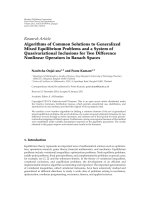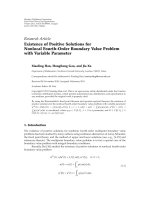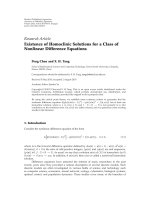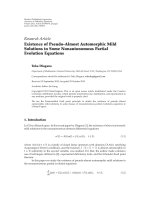Báo cáo hóa học: " Research Article Existence of Positive Solutions for Nonlocal Fourth-Order Boundary Value Problem with Variable Parameter" doc
Bạn đang xem bản rút gọn của tài liệu. Xem và tải ngay bản đầy đủ của tài liệu tại đây (498.05 KB, 11 trang )
Hindawi Publishing Corporation
Fixed Point Theory and Applications
Volume 2011, Article ID 604046, 11 pages
doi:10.1155/2011/604046
Research Article
Existence of Positive Solutions for
Nonlocal Fourth-Order Boundary Value Problem
with Variable Parameter
Xiaoling Han, Hongliang Gao, and Jia Xu
Department of Mathematics, Northwest Normal University, Lanzhou 730070, China
Correspondence should be addressed to Xiaoling Han,
Received 26 November 2010; Accepted 14 January 2011
Academic Editor: M. Furi
Copyright q 2011 Xiaoling Han et al. This is an open access article distributed under the Creative
Commons Attribution License, which permits unrestricted use, distribution, and reproduction in
any medium, provided the original work is properly cited.
By using the Krasnoselskii’s fixed point theorem and operator spectral theorem, the existence of
positive solutions for the nonlocal fourth-order boundary value problem with variable parameter
u
4
tBtu
tλft, ut,u
t,0<t<1, u0u1
1
0
psusds, u
0u
1
1
0
qsu
sds is considered, where p, q ∈ L
1
0, 1,λ>0isaparameter,andB ∈ C0, 1, f ∈
C0, 1 × 0, ∞ × −∞, 0, 0, ∞.
1. Introduction
The existence of positive solutions for nonlinear fourth-order multipoint boundary value
problems has been studied by many authors using nonlinear alternatives of Leray-Schauder,
the fixed point theory, and the method of upper and lower solutions see, e.g., 1–15 and
references therein. The multipoint boundary value problem is in fact a special case of the
boundary value problem with integral boundary conditions.
Recently, Bai 16 studied the existence of positive solutions of nonlocal fourth-order
boundary value problem
u
4
t
βu
t
λf
t, u
t
,u
t
, 0 <t<1,
u
0
u
1
1
0
p
s
u
s
ds,
u
0
u
1
1
0
q
s
u
s
ds.
1.1
2 Fixed Point Theory and Applications
under the assumption:
A1 λ>0and0<β<π
2
,
A2 f ∈ C0, 1×0, ∞×−∞, 0, 0, ∞, p, q ∈ L
1
0, 1, ps ≥ 0, qs ≥ 0,
1
0
psds < 1,
1
0
qs sin
βsds
1
0
qs sin
β1 −sds < sin
β.
In this paper, we study the above generalizing form with variable parameters BVP
u
4
t
B
t
u
t
λf
t, u
t
,u
t
, 0 <t<1,
u
0
u
1
1
0
p
s
u
s
ds,
u
0
u
1
1
0
q
s
u
s
ds,
1.2
where B ∈ C0, 1, λ>0isaparameter.
Obviously, BVP1.1 can be regarded as the special case of BVP1.2 with Btβ.
Since the parameters Bt is variable, we cannot expect to transform directly BVP1.2 into
an integral equation as in 16. We will apply the cone fixed point theory, combining with
the operator spectra theorem to establish the existence of positive solutions of BVP1.2.Our
results generalize the main result in 16.
Let β inf
t∈0,1
Bt, and we assume that the following conditions hold throughout the
paper:
H1 B ∈ C0, 1 and 0 <β<π
2
,
H2 f ∈ C0, 1 × 0, ∞ × −∞, 0, 0, ∞, p, q ∈ L
1
0, 1, ps ≥ 0, qs ≥ 0and
1
0
psds < 1,
1
0
qs sin
βsds
1
0
qs sin
β1 −sds < sin
β.
2. T he Preliminary Lemmas
Set λ
1
0, −π
2
<λ
2
−β<0and
δ
1
1 −
1
0
p
s
ds, δ
2
sin
β −
1
0
q
s
sin
βsds −
1
0
q
s
sin
β
1 −s
ds.
2.1
By H1, H2,wegetδ
i
/
0, i 1, 2. Denote by K
1
t, s the Green’s function of the problem
−u
t
λ
1
u
t
0, 0 <t<1,
u
0
u
1
1
0
p
s
u
s
ds
2.2
Fixed Point Theory and Applications 3
and K
2
t, s the Green’s function of the problem
−u
t
λ
2
u
t
0, 0 <t<1,
u
0
u
1
1
0
q
s
u
s
ds.
2.3
Then, carefully calculation yield
K
1
t, s
G
1
t, s
ρ
1
1
0
G
1
s, x
p
x
dx,
K
2
t, s
G
2
t, s
ρ
2
t
1
0
G
2
s, x
q
x
dx,
G
1
t, s
⎧
⎨
⎩
t
1 −s
, 0 ≤ t ≤ s ≤ 1,
s
1 −t
, 0 ≤ s ≤ t ≤ 1,
G
2
t, s
⎧
⎪
⎪
⎪
⎪
⎪
⎪
⎨
⎪
⎪
⎪
⎪
⎪
⎪
⎩
sin
βt sin
β
1 −s
β sin
β
, 0 ≤ t ≤ s ≤ 1,
sin
βs sin
β
1 −t
β sin
β
, 0 ≤ s ≤ t ≤ 1,
ρ
1
1
δ
1
,ρ
2
t
sin
βt sin
β
1 − t
δ
2
.
2.4
Lemma 2.1 see 16. Suppose that (A1), (A2) hold. Then, for any h ∈ C0, 1, u solves the problem
u
4
t
βu
t
h
t
, 0 <t<1,
u
0
u
1
1
0
p
s
u
s
ds,
u
0
u
1
1
0
q
s
u
s
ds,
2.5
if and only if ut
1
0
1
0
K
1
t, sK
2
s, τhτdτds.
Let Y C0, 1,Y
{u ∈ Y : ut ≥ 0,t ∈ 0, 1},andu
0
max
0≤t≤1
|ut|,foru ∈ Y .
X {u ∈ C
2
0, 1 : u0u1
1
0
psusds, u
0u
1
1
0
qsu
sds}, u
1
u
0
,
u
2
u
0
u
1
,foru ∈ X.
It is easy to show that u
1
, u
2
are norms on X.
4 Fixed Point Theory and Applications
Lemma 2.2 see 16. ·
1
≤·
2
≤ 1 δ
1
·
1
and (X, ·
2
) is a Banach space.
Lemma 2.3 see 5. Assume that (A1), (A2) hold. Then,
i K
i
t, s ≥ 0,fort, s ∈ 0 , 1, i 1, 2; K
i
t, s > 0,fort, s ∈ 0 , 1, i 1, 2,
ii G
i
t, s ≥ b
i
G
i
t, tG
i
s, s, G
i
t, s ≤ C
i
G
i
s, s for t, s ∈ 0, 1, i 1, 2,
where C
1
1, b
1
1; C
2
1/ sin
β, b
2
β sin
β.
Denote
d
i
min
1/4≤t≤3/4
b
i
G
i
t, t
i 1, 2
,
ξ
min
1/4≤t≤3/4
ρ
2
t
max
1/4≤t≤3/4
ρ
2
t
,
D
i
max
t∈0,1
1
0
K
i
t, s
ds
i 1, 2
.
2.6
Computations yield the following results.
Lemma 2.4 see 3. D
1
i
max
t∈0,1
1
0
G
i
t, sds > 0 i 1, 2
i when λ
i
> 0, D
1
i
1/λ
i
1 −1/ cosω
i
/2,
ii when λ
i
0, D
1
i
1/8,
iii when −π
2
<λ
i
< 0, D
1
i
1/λ
i
1 −1/ cosω
i
/2.
Lemma 2.5 see 16. Suppose that (A1), (A2) hold and ρ
2
t, d
i
, ξ are given as above. Then,
i max
t∈0,1
ρ
2
tρ
2
1/2,
ii 0 <d
i
< 1, 0 <ξ<1.
By Lemmas 2.4 and 2.5, D
2
max
t∈0,1
1
0
K
2
1/2,sds.
Take θ min{d
1
,d
2
ξ/C
2
},byLemma 2.5,0<θ<1.
Define
Th
t
1
0
1
0
K
1
t, s
K
2
s, τ
h
τ
dτ ds, t ∈
0, 1
,
Ah
t
Th
t
−
1
0
K
2
t, τ
h
τ
dτ, t ∈
0, 1
.
2.7
Lemma 2.6. T : Y → X, ·
2
is completely continuous, and T≤D
2
.
Proof. It is similar to Lemma 6 of 3 ,soweomitit.
Fixed Point Theory and Applications 5
Lemma 2.7 see 17. Let E be a Banach space, P ⊆ E a cone, and Ω
1
, Ω
2
be two bounded open sets
of E with 0 ∈ Ω
1
⊂ Ω
1
⊂ Ω
2
. Suppose that A : P ∩ Ω
2
\ Ω
1
→ P is a completely continuous
operator such that either
i Ax≤x,x ∈ P ∩ ∂Ω
1
and Ax≥x, x ∈ P ∩ ∂Ω
2
,or
ii Ax≥x,x ∈ P ∩ ∂Ω
1
and Ax≤x, x ∈ P ∩ ∂Ω
2
holds. Then, A has a fixed point in P ∩ Ω
2
\ Ω
1
.
3. The Main Results
Suppose that K
1
, K
2
, G
2
, ρ
2
, C
2
, θ,andD
2
,aredefinedasinSection 2,weintroducesome
notations as follows:
A
1
0
1
0
K
1
s, s
K
2
s, τ
dτ ds, B
1
0
G
2
s, s
ρ
2
1
2
1
0
G
2
s, x
q
x
dx
ds,
K sup
t∈0,1
B
t
− β
,L D
2
K, η
0
1 −L
A C
2
B
,η
1
1
θ
3/4
1/4
K
2
1/2,τ
dτ
,
f
0
lim sup
|u||v|→0
max
t∈0,1
f
t, u, v
|
u
|
|
v
|
,f
0
lim inf
|u||v|→0
min
t∈1/4,3/4
f
t, u, v
|
u
|
|
v
|
,
f
∞
lim sup
|u||v|→∞
max
t∈0,1
f
t, u, v
|
u
|
|
v
|
,f
∞
lim inf
|u||v|→∞
min
t∈1/4,3/4
f
t, u, v
|
u
|
|
v
|
.
3.1
Theorem 3.1. Assume that (H1), (H2) hold and L D
2
K<1.ThenBVP1.2 has at least one
positive solution if one of the following cases holds:
i
f
0
< 1/λη
0
, f
∞
> 1/λη
1
,
ii f
0
> 1/λη
1
, f
∞
< 1/λη
0
.
Proof. For any h ∈ Y , consider the following BVP:
u
4
t
B
t
u
t
h
t
, 0 <t<1,
u
0
u
1
1
0
p
s
u
s
ds,
u
0
u
1
1
0
q
s
u
s
ds.
3.2
6 Fixed Point Theory and Applications
It is easy to see that the above question is equivalent to the following question:
u
4
t
βu
t
−
B
t
− β
u
t
h
t
, 0 <t<1,
u
0
u
1
1
0
p
s
u
s
ds,
u
0
u
1
1
0
q
s
u
s
ds.
3.3
For any v ∈ X,letGv −Bt − βv
. Obviously, the operator G : X → Y is linear.
By Lemma 2.2,forallv ∈ X, t ∈ 0, 1, |Gvt|≤Bt − βv
1
≤ Kv
1
≤ Kv
2
.Hence
Gv
0
≤ Kv
2
,andsoG≤K. On the other hand, u ∈ C
2
0, 1 ∩ C
4
0, 1 is a solution of
3.3 if and only if u ∈ X satisfies u TGu h,thatis,
u ∈ X,
I − TG
u Th. 3.4
Owing to G : X → Y and T : Y → X, the operator I −TG maps X into X.FromT≤D
2
by
Lemma 2.6 together with G≤K and condition L<1, applying operator spectral theorem,
we have that the I −TG
−1
exists and is bounded. Let H I −TG
−1
T,then3.4 is equivalent
to u Hh. By the Neumann expansion formula, H can be expressed by
H
I TG ···
TG
n
···
T T
TG
T ···
TG
n
T ···. 3.5
The complete continuity of T with the continuity of I − TG
−1
yields that the operator H :
Y → X is completely continuous. For all h ∈ Y
,letu Th,thenu ∈ X ∩ Y
,andu
< 0.
So, we have Gut−Bt − βu
t ≥ 0, t ∈ 0, 1.Hence,
∀h ∈ Y
,
GTh
t
≥ 0,t∈
0, 1
, 3.6
and so TGThtTGTht ≥ 0, t ∈ 0, 1.
Assume that for all h ∈ Y
, TG
k
Tht ≥ 0, t ∈ 0, 1,leth
1
GTh,by3.6 we have
h
1
∈ Y
,andsoTG
k1
ThtTG
k
TGThtTG
k
Th
1
t ≥ 0, t ∈ 0 , 1.Thusby
induction, it follows that TG
n
Tht ≥ 0, for all n ≥ 1, h ∈ Y
, t ∈ 0, 1.By3.5,forall
h ∈ Y
,wehave
Hh
t
Th
t
TG
Th
t
···
TG
n
Th
t
···≥
Th
t
,t∈
0, 1
,
Hh
t
Ah
t
AG
Th
t
···
AG
TG
n−1
Th
t
···
≤
Ah
t
Th
t
≤ 0,t∈
0, 1
,
3.7
and so H : Y
→ Y
∩ X.
Fixed Point Theory and Applications 7
On the other hand, for all h ∈ Y
,wehave
Hh
t
≤
Th
t
|
TG
|
Th
t
···
|
TG
|
n
Th
t
···
≤
1 L ··· L
n
···
Th
t
1
1 − L
Th
t
t ∈
0, 1
,
3.8
Hh
t
≤
|
Ah
t
|
|
AG
Th
t
|
···
AG
TG
n−1
Th
t
···
≤
|
Ah
t
|
L
|
Ah
t
|
··· L
n
|
Ah
t
|
···
1 L ··· L
n
···
|
Ah
t
|
1
1 − L
Th
t
t ∈
0, 1
,
3.9
Hh
0
≥
Th
0
,
Hh
0
≤
1
1 −L
Th
0
,
Hh
1
≥
Th
1
,
Hh
1
≤
1
1 −L
Th
1
.
3.10
For any u ∈ Y
,defineFu λft, u, u
.ByH1 and H2,wehavethatF : Y
→ Y
is
continuous. It is easy to see that u ∈ C
2
0, 1 ∩ C
4
0, 1 being a positive solution of BVP1.2
is equivalent to u ∈ Y
being a nonzero solution equation as follows:
u HFu. 3.11
Let Q HF. Obviously, Q : Y
→ Y
is completely continuous. We next show that the
operator Q has a nonzero fixed point in Y
.Let
P
u ∈ X : u ≥ 0,u
≤ 0, min
1/4≤t≤3/4
u
t
≥
1 −L
d
1
u
0
, max
1/4≤t≤3/4
u
t
≤−
1 −L
d
2
ξ
C
2
u
0
.
3.12
It is easy to know that P is a cone in X, P ⊂ Y
.Now,weshowQP ⊂ P .
For h ∈ Y
,by2.7,thereisTh ≥ 0, Th
≤ 0. Hence, by 3.7, Qu ≥ 0, Qu
≤ 0, u ∈
P. By proof of Lemma 2.5 in 16,
min
1/4≤t≤3/4
Th
t
≥ d
1
Th
0
, max
1/4≤t≤3/4
Th
t
≤−
d
2
ξ
C
2
Th
0
.
3.13
8 Fixed Point Theory and Applications
By 3.7 and 3.10,
min
1/4≤t≤3/4
Qu
t
≥ min
1/4≤t≤3/4
TFu
t
≥ d
1
TFu
0
≥
1 −L
d
1
Qu
0
,
max
1/4≤t≤3/4
Qu
t
≤ max
1/4≤t≤3/4
TFu
t
≤−
d
2
ξ
C
2
TFu
0
≤−
1 −L
d
2
ξ
C
2
Qu
0
.
3.14
Thus QP ⊂ P.
i Since
f
0
< 1/λη
0
, by the definition of f
0
,thereexistsr
1
> 0suchthat
max
0≤t≤1,
|
ut
|
|
u
t
|
≤r
1
f
t, u
t
,u
t
≤
r
1
λ
η
0
.
3.15
Let Ω
r
1
{u ∈ P : u
2
<r
1
}, one has
f
t, u
t
,u
t
≤
r
1
λ
η
0
,u∈ ∂Ω
r
1
,t∈
0, 1
.
3.16
So, by 3.10,weget
Qu
0
HFu
0
≤
1
1 −L
TFu
0
λ
1 −L
1
0
1
0
K
1
t, s
K
2
s, τ
f
τ, u
τ
,u
τ
dτ ds
0
≤
r
1
η
0
1 −L
1
0
1
0
K
1
s, s
K
2
s, τ
dτ ds ≤
Aη
0
r
1
1 −L
,
Qu
1
HFu
1
≤
1
1 −L
TFu
1
≤ λC
2
1
1 −L
1
0
G
2
τ, τ
ρ
2
1
2
1
0
G
2
τ, x
q
x
dx
f
τ, u
τ
,u
τ
dτ
≤
C
2
Bη
0
r
1
1 −L
.
3.17
Hence, for u ∈ ∂Ω
r
1
,
Qu
2
HFu
2
≤
1
1 −L
TFu
2
≤
A BC
2
η
0
r
1
1 −L
r
1
u
2
.
3.18
Fixed Point Theory and Applications 9
On the other hand, since f
∞
> 1/λη
1
,thereexistsr
2
>r
1
> 0suchthat
min
1/4≤t≤3/4,θ|ut||u
t|≥r
2
f
t, u
t
,u
t
|
u
t
|
|
u
t
|
≥
1
λ
η
1
.
3.19
Choose r
2
> 1/θr
2
,letΩ
r
2
{u ∈ P : u
2
<r
2
}.Foru ∈ ∂Ω
r
2
, t ∈ 1/4, 3/4,thereis
r
2
≤ θr
2
≤|ut| |u
t|≤r
2
.Thus,
f
t, u
t
,u
t
≥
θr
2
λ
η
1
,u∈ ∂Ω
r
2
,t∈
1
4
,
3
4
.
TFu
1
2
λ
1
0
K
2
1
2
,τ
f
τ, u
τ
,u
τ
dτ
≥ λ
3/4
1/4
K
2
1
2
,τ
f
τ, u
τ
,u
τ
dτ ≥ η
1
θr
2
3/4
1/4
K
2
1
2
,τ
dτ r
2
.
3.20
Hence, for u ∈ Ω
r
2
,
Qu
2
≥
TFu
2
≥
TFu
1
2
≥ r
2
u
2
. 3.21
By the use of the Krasnoselskii’s fixed point theorem, we know there exists u
0
∈ Ω
2
\Ω
1
such
that Qu
0
u
0
,namely,u
0
is a solution of 1.2 and satisfied u
0
≥ 0, u
0
≤ 0, r
1
≤u
0
2
≤ r
2
.
ii The proof is similar to i,soweomitit.
Corollary 3.2. Assume that (H1), (H2) hold, and L<1. Then that 1.2 has at least two positive
solution, if f satisfy
i
f
0
< 1/λη
0
, f
∞
< 1/λη
0
,
ii There exists R
0
> 0 such that ft, u, v ≥ θR
0
/λη
1
,fort ∈ 1/4, 3/4, |u| |v|≥θR
0
.
Proof. By the proof of Theorem 3.1, we know that 1 from the condition
f
0
< 1/λη
0
,there
exists Ω
r
1
{u ∈ P : u
2
<r
1
},suchthatQu
2
≤u
2
, u ∈ ∂Ω
r
1
, 2 from the condition
f
∞
< 1/λη
0
,thereexistsΩ
r
2
{u ∈ P : u
2
<r
2
}, r
2
>r
1
,suchthatQu
2
≤u
2
, u ∈ ∂Ω
r
2
,
3 from the condition ii,thereexistsΩ
r
3
{u ∈ P : u
2
<r
3
}, r
2
>r
3
>r
1
,suchthat
Qu
2
≥u
2
, u ∈ ∂Ω
r
3
. By the use of Krasnoselskii’s fixed point theorem, it is easy to know
that 1.2 has at least two positive solutions.
Corollary 3.3. Assume (H1), (H2) hold, and L<1.Thenproblem1.2 has at least two positive
solution, if f satisfy
i f
0
> 1/λη
1
, f
∞
> 1/λη
1
,
ii There exists R
0
> 0 such that ft, u, v ≤ θR
0
/λη
0
,fort ∈ 0, 1, |u| |v|≤R
0
.
Proof. The proof is similar to Corollary 3.2,soweomitit.
10 Fixed Point Theory and Applications
Example 3.4. Consider the following boundary value problem
u
4
t
π
2
4
t
u
t
π
2
18
u
t
− u
t
− 17.9sin
u
t
− u
t
, 0 <t<1,
u
0
u
1
1
0
su
s
ds,
u
0
u
1
0.
3.22
In this problem, we know that Btπ
2
/4 t, ptt,qt0, λ π
2
,thenwecanget
C
1
1, C
2
1, ρ
1
1, ρ
2
√
2, β π
2
/4, K 1, D
2
4
√
2 −1/π
2
.Furthermore,weobtain
A 48 − 13π
2
/π
3
, B 2/π
2
,thenη
0
1 −Lπ
3
/48 − 11π, η
1
4π
2
/
√
2cosπ/8 − 1, so
f
0
0.1 <
1
π
2
η
0
≈ 0.19,f
∞
18 >
1
π
2
η
1
≈ 13.3.
3.23
Thus, Bt, pt, qt,andf satisfy the conditions of Theorem 3.1, and there exists at least a
positive solution of the above problem.
Acknowledgments
This work is sponsored by the NSFC no. 11061030,NSFCno. 11026060, and nwnu-kjcxgc-
03-69, 03-61.
References
1 Z. Bai, “The method of lower and upper solutions for a bending of an elastic beam equation,” Journal
of Mathematical Analysis and Applications, vol. 248, no. 1, pp. 195–202, 2000.
2 Z. Bai, “The upper and lower solution method for some fourth-order boundary value problems,”
Nonlinear Analysis. Theory, Methods & Applications, vol. 67, no. 6, pp. 1704–1709, 2007.
3 G. Chai, “Existence of positive solutions for fourth-order boundary value problem with variable
parameters,” Nonlinear Analysis. Theory, Methods & Applications, vol. 66, no. 4, pp. 870–880, 2007.
4 H. Feng, D. Ji, and W. Ge, “Existence and uniqueness of solutions for a fourth-order boundary value
problem,” Nonlinear Analysis. Theory, Methods & Applications, vol. 70, no. 10, pp. 3561–3566, 2009.
5 Y. Li, “Positive solutions of fourth-order boundary value problems with two parameters,” Journal of
Mathematical Analysis and Applications, vol. 281, no. 2, pp. 477–484, 2003.
6 Y. Li, “Positive solutions o f fourth-order periodic boundary value problems,” Nonlinear Analysis.
Theory, Methods & Applications, vol. 54, no. 6, pp. 1069–1078, 2003.
7 X L. Liu and W T. Li, “Existence and multiplicity of solutions for fourth-order boundary value
problems with three parameters,” Mathematical and Computer Modelling, vol. 46, no. 3-4, pp. 525–534,
2007.
8 H. Ma, “Symmetric positive solutions for nonlocal boundary value problems of fourth order,”
Nonlinear Analysis. Theory, Methods & Applications, vol. 68, no. 3, pp. 645–651, 2008.
9 R. Ma, “Existence of positive solutions of a fourth-order boundary value problem,” Applied
Mathematics and Computation, vol. 168, no. 2, pp. 1219–1231, 2005.
10 C. Pang, W. Dong, and Z. Wei, “Multiple solutions for fourth-order boundary value problem,” Journal
of Mathematical Analysis and Applications, vol. 314, no. 2, pp. 464–476, 2006.
Fixed Point Theory and Applications 11
11 Z. Wei and C. Pang, “Positive solutions and multiplicity of fourth-order m-point boundary value
problems with two parameters,” Nonlinear Analysis. Theory, Methods & Applications,vol.67,no.5,pp.
1586–1598, 2007.
12 Y. Yang and J. Zhang, “Existence of solutions for some fourth-order boundary value problems with
parameters,” Nonlinear Analysis. Theory, Methods & Applications, vol. 69, no. 4, pp. 1364–1375, 2008.
13 Q. L. Yao and Z. B. Bai, “Existence of positive solutions of a BVP for u
4
t −λhtfut 0,” Chinese
Annals of Mathematics. Series A, vol. 20, no. 5 , pp. 575–578, 1999.
14 Q. Yao, “Local existence of multiple positive solutions to a singular cantilever beam equation,” Journal
of Mathematical Analysis and Applications, vol. 363, no. 1, pp. 138–154, 2010.
15 J. Zhao and W. Ge, “Positive solutions for a higher-order four-point boundary value problem with a
p-Laplacian,” Computers & Mathematics with Applications, vol. 58, no. 6, pp. 1103–1112, 2009.
16 Z. Bai, “Positive solutions of some nonlocal fourth-order boundary value problem,” Applied
Mathematics and Computation, vol. 215, no. 12, pp. 4191–4197, 2010.
17 D. J. Guo and V. Lakshmikantham, Nonlinear Problems in Abstract Cones, vol. 5 of Notes and Reports in
Mathematics in Science and Engineering, Academic Press, Boston, Mass, USA, 1988.









